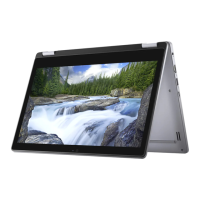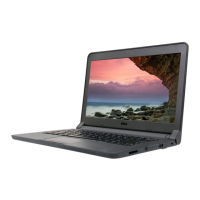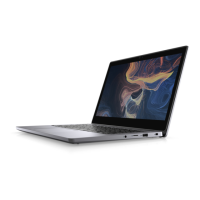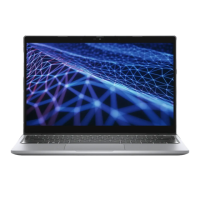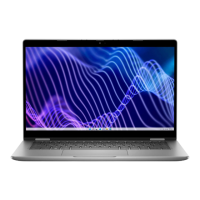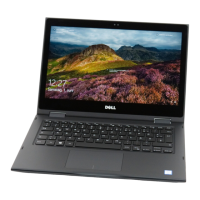



Do you have a question about the Dell Latitude 3300 and is the answer not in the manual?
Details the features and purpose of the Dell Latitude 3300.
Describes the physical layout and components of the laptop's chassis.
Illustrates the bottom view of the laptop, identifying key components.
Shows the ports and connectors on the left side of the laptop.
Shows the ports and connectors on the right side of the laptop.
Illustrates the front view of the laptop, showing camera and microphone.
Compares the Dell Latitude 3300 with its predecessor, the Latitude 3380.
Details the available Intel processors, their specifications, and integrated graphics.
Outlines the memory types, configurations, and speeds supported by the system.
Lists the available M.2 SSD and eMMC storage drive types and capacities.
Describes the type of media card reader and supported card formats.
Details the audio controller, speaker type, and interface options.
Specifies controller, graphics memory, display support, and resolution.
Identifies and describes the various ports and connectors on the laptop.
Provides details on screen type, resolution, size, and viewing angles.
Details keyboard layout, number of keys, and key pitch.
Details touchpad resolution, dimensions, and multi-touch support.
Lists the operating systems supported by the system.
Details battery types, dimensions, voltage, lifespan, and charging times.
Specifies power adapter types, input/output voltage, and operating temperatures.
Provides the physical dimensions and weight of the laptop.
Details environmental operating and storage conditions for the computer.
Lists security features like TPM and support for Windows Hello.
Lists available security software options for the system.
Lists function key combinations for common system operations.
Explains the Unified Extensible Firmware Interface and its implementation.
Details DDR4 memory technology, including notch differences and features.
Provides steps to check system memory via OS and BIOS setup.
Outlines essential safety guidelines for handling electronic components and the system.
Pre-service checks and preparations required before disassembling the system.
Explains ESD risks and methods for preventing damage to components.
Step-by-step guide for removing and installing the system's primary battery.
Instructions for removing and installing RAM modules.
Instructions for removing and installing the Solid State Drive (SSD).
Procedure for removing and installing the system's keyboard.
Steps for removing and installing the laptop's touch pad.
Detailed steps for removing and installing the entire display unit.
Guide for removing and installing the screen's bezel.
Instructions for safely removing and installing the main system board.
Details on removing and installing the palmrest assembly.
Explains how to access and use the system's one-time boot menu.
Details various system configuration settings like general, video, and security.
Configures integrated NIC, SATA operation, and other system devices.
Covers admin passwords, system passwords, and UEFI boot path security.
Configures system power behavior, including battery charging and sleep modes.
Guides on updating the system BIOS via Windows or USB.
Instructions for setting, changing, or deleting system and BIOS setup passwords.
Interprets the meaning of different battery indicator light patterns.
Explains blinking patterns on the LED and their corresponding error codes.
Details the Built-In Self-Test diagnostics tool for system board failures.
Provides steps to recover from No Post, No Power, or No Video situations.
Provides procedures for recovering the BIOS using hard drive or USB.
Guide to running the built-in self test for screen abnormalities.
Instructions on running the embedded pre-boot system assessment for hardware checks.
Explains how ePSA reports errors and how to interpret them.
Provides steps to find contact information and support resources from Dell.
| Graphics | Intel UHD Graphics 620 |
|---|---|
| Operating System | Windows 10 Pro |
| RAM | 4GB/8GB DDR4 |
| Storage | 1TB HDD |
| Display | 13.3-inch HD (1366 x 768) |
| Battery | 3-Cell 42 WHr Battery |
| Ports | HDMI |
| Wireless | 802.11ac Wi-Fi, Bluetooth 4.2 |
| Processor | 8th Generation Intel Core i5-8265U |

